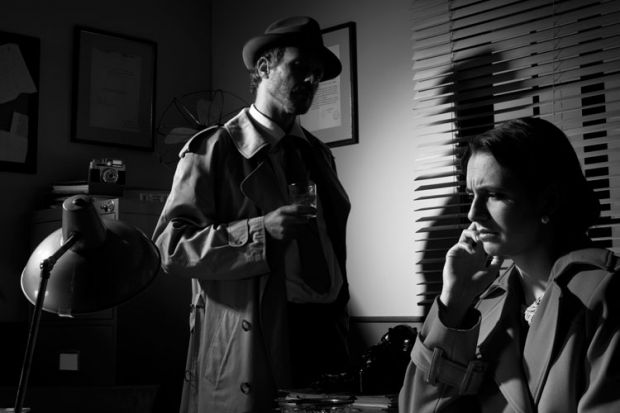So that’s another myth demolished. The private eye wasn’t a battered but chivalric loner with an eye for damsels in distress and whiskey in his desk drawer. According to John Walton, he was more likely to have been a strike-breaker who was rather too fond of frame-ups, working for a big agency and with a wife and sprogs at home.
Walton, a sociologist, has set out to map the growth of private detective agencies, as well as pinpointing where fact and fiction diverge. But if you have the Dick Barton – Special Agent music galloping through your brain, or are wallowing in memories of Dashiell Hammett and Raymond Chandler and their mean streets, you might want to bear in mind that that’s not Walton’s prime focus: “The history of the private detective is all the more compelling because it is a history intended not to be told – a history, in important part, that has been silenced, suppressed, and substituted with fiction. Many of the activities of the great agencies were duplicitous, ranging from offensive and marginally legal to criminal and destructive.”
This study concentrates on the US between the mid-19th century, with the birth of agencies such as Pinkerton, and the 1930s and 1940s, when they were in decline. Walton’s research is hampered by the fact that records were routinely destroyed. Those that survive had either been subpoenaed or leaked by insiders. And much of the paperwork is cloak and dagger, with people disguised by initials and numbers.
Walton undertakes careful forensic history to piece together the characters and the cases. In doing so, he allows us to see why novelists didn’t want to let the facts stand in the way of a good story – a flawed character is one thing, but it’s quite another to have to persuade your reader that a union-buster or labour spy is a viable hero.
Some of the people Walton uncovers seem to spring from the pages of detective fiction – the cowboy detective Charles Angelo Siringo, who also fancied himself as a writer; William J. Burns, the self-styled America’s Greatest Detective, who moved from the Secret Service to agency boss; Nick Harris, a journalist and true-crime writer who set up his own agency; and the redoubtable Cora Strayer, who founded an agency in Chicago in the 1890s.
Walton’s examination of the detective in fiction is little more than cursory, skimming over Edgar Allan Poe, detective memoirs, pulp fiction and magazines. He points to the growth of the hard-boiled writer from the 1920s, and reckons it’s between Carroll John Daly and Hammett (himself a former Pinkerton op) for the first story in 1923 in the pulp magazine Black Mask, the birthplace of the hard-boiled story. Female writers, including Craig Rice, are dismissed in a sentence. And you’ve got to wonder about a chapter that mentions Chandler only once.
From a historical point of view, The Legendary Detective has much to recommend it, not least Walton’s revealing of the agencies’ murky practices. For the crime fiction buff, however, it won’t provide much that’s new. And, sadly, the book doesn’t give you a single clue about the significant influence that women, black and gay writers have had in breathing new life into the PI trope.
Sharon Wheeler is visiting lecturer in journalism at Birmingham City University and co-editor of Crime Review
The Legendary Detective: The Private Eye in Fact and Fiction
By John Walton
University of Chicago Press, 232pp, £17.50
ISBN 9780226308265 and 8432 (e-book)
Published 17 November 2015
POSTSCRIPT:
Print headline: Mean men down mean streets
Register to continue
Why register?
- Registration is free and only takes a moment
- Once registered, you can read 3 articles a month
- Sign up for our newsletter
Subscribe
Or subscribe for unlimited access to:
- Unlimited access to news, views, insights & reviews
- Digital editions
- Digital access to THE’s university and college rankings analysis
Already registered or a current subscriber?




